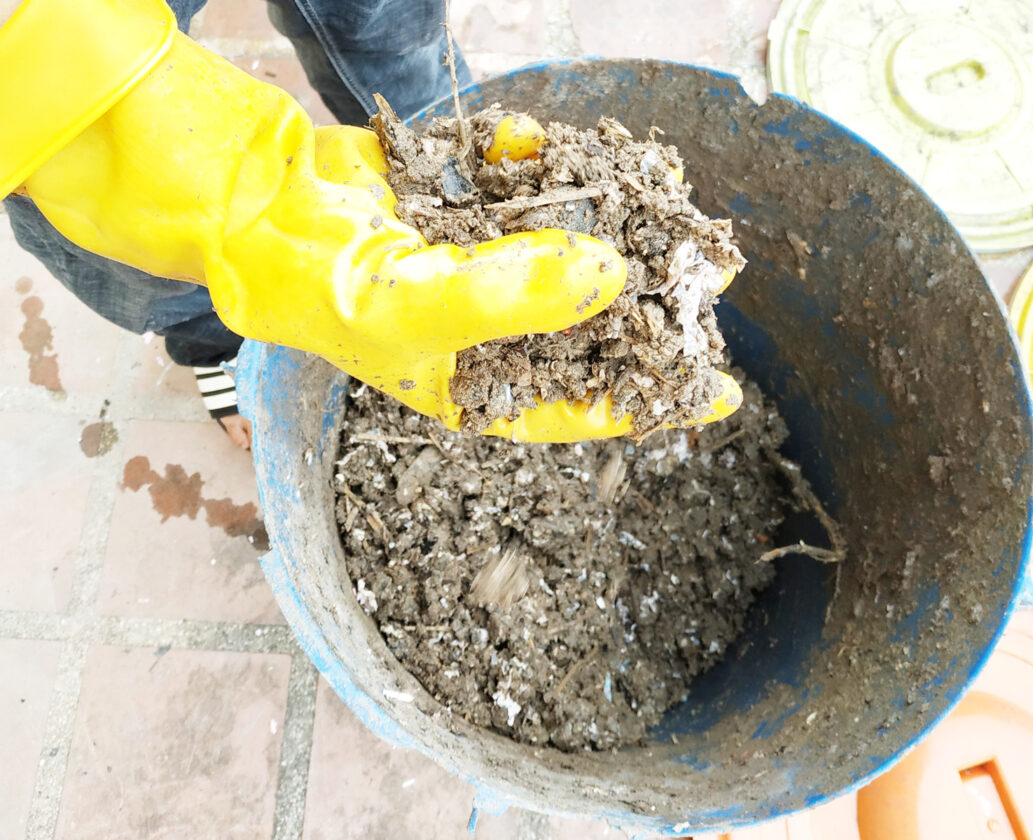
A longtime apartment composter offers techniques and tips that make recycling organic waste in cramped spaces not just possible but also accessible.

by Jennie Mae Ong
Hot composting in buckets will give you finished compost quickly, after only 2 to 3 months.
Composting in a city without a yard is a challenge. I’ve always lived in an apartment but loved the idea of composting, so I’ve tested many methods to find one that ticks all my boxes: compact, pest-proof, and low-maintenance. Luckily, home composters have honed techniques to meet these needs, including the Bokashi method, hot composting with buckets, compost tumblers, and worm hotels.
The two biggest issues with small-scale composting setups are odors and pests, so let’s address those issues before diving into the many composting options available to a city dweller.
Pests, such as cockroaches, flies, and rodents, are the most common problems. But these two tips alone can eliminate the problem: First, don’t put meats, oily foods, or cooked foods in your compost bin. Second, keep your bin closed at all times.
Managing bad odors is much harder. Even experts will occasionally end up with a stinky compost bin. The most crucial steps for managing odors are sufficiently aerating the pile and adding enough shredded paper or shredded cardboard.
Aerate your compost frequently to prevent bad odors. To aerate, turn your compost every three days if it’s still fresh or still contains a lot of identifiable kitchen scraps. This is the game changer that will spell the difference between having bad odor or not. If the compost is a bit mature or you can’t identify the scraps you put in it, you can just turn it every five days.
Another reason a compost pile can smell bad is that it’s too wet, because kitchen scraps naturally produce a lot of liquid as they break down. To address the wetness, add a lot of absorbent materials, such as paper and cardboard.
Bokashi Composting Method

picture by Jennie Mae Ong
The Bokashi method involves fermenting waste in an airtight environment to produce pre-compost.
The Bokashi method involves fermenting or picking your kitchen waste in an airless environment using bacteria, which turns the scraps into pre-compost. It’s not compost, so you’ll still have to process it to become compost. This method can handle meat, oil, and cooked food. Just don’t put seafood in there; it’s guaranteed to smell.
Be warned that odors are an issue with the Bokashi method, even when you get things right. Every time you open your Bokashi bucket, a strong, sour smell will come out. I like to open mine quickly and turn on the exhaust to dissipate the smell.
To begin, you just need a sealed container with a spigot and Bokashi bran.
To use the Bokashi composting method:
- Put your food scraps or food waste into the Bokashi bucket.
- Cover food waste with about 1/2 inch Bokashi bran.
- Wearing plastic or rubber gloves, press down on the waste to pack it in and remove air, and then close the lid.
- Drain the liquid through the spigot every 2 to 3 days to prevent liquid buildup.
- Let the bin cure undisturbed for 2 to 3 weeks. Start counting from the last time you put anything in your bin.

picture by Jennie Mae Ong
Pre-compost that you can break down in your yard or garden.
The best way to process your pre-compost is to bury it. (If this isn’t possible, send it to a municipal composting service or give it away to a recipient who can handle Bokashi.) In a large wooden box, bury the pre-compost in soil. Layer it with soil, then shredded paper or cardboard, then Bokashi compost, and repeat as needed. Use a sackful or two of soil; the pre-compost won’t break down if you don’t use enough soil. Turn this every three days. It will finish curing in as little as one month.
Tips: If you put in a lot of meat or oily foods, dump in a 1-1/2-to-2-inch-thick layer of Bokashi bran to head off odor problems. If you underdo the Bokashi bran, the entire bin will reek of rotting garbage.
White molds growing on your food scraps means the method is going well. Black molds mean you need to throw out the contents of the bin.
Indoor Worm Composting

picture by Jennie Mae Ong
Composting in a worm hotel is the most low-maintenance method.
For the most no-fuss composting, opt for a low-maintenance worm bin composed of stackable bins. All you have to do is feed the worms scraps and add a bin every time the top one that holds the worms gets filled up with their castings.
To set up a worm hotel:
- Buy a worm bin with a built-in spigot at the bottom to allow you to collect the “worm tea.” Assemble your bin with two tray layers. Place your bin in a dark, quiet place that’s not too warm or cold.
- Source your worms. I use African nightcrawlers or red wrigglers. These worms work best because they have a voracious appetite and can work through your kitchen scraps quickly.
- Line both trays with paper for bedding; make sure to moisten it first.
- Toss your scraps into the trays.
- When your first two trays are filled with castings, add a tray beneath and start placing your kitchen scraps there so the worms will burrow down to feed.
 Your worm hotel will produce one of the best fertilizers: “Vermicast,” or worm poop, is sought after by many organic gardeners and farmers. Harvesting this fertilizer is doable even for the fainthearted. Open the worm hotel and shine a powerful light on it for at least 30 minutes. This will drive the worms to burrow down. You can then harvest the castings they leave behind. Carefully remove any worms left in the vermicast and place them back in the bin.
Your worm hotel will produce one of the best fertilizers: “Vermicast,” or worm poop, is sought after by many organic gardeners and farmers. Harvesting this fertilizer is doable even for the fainthearted. Open the worm hotel and shine a powerful light on it for at least 30 minutes. This will drive the worms to burrow down. You can then harvest the castings they leave behind. Carefully remove any worms left in the vermicast and place them back in the bin.
Tips: It’s better to underfeed than overfeed. Feed only when half the kitchen scraps from the last feeding are gone.
Keep their home moist, like a wrung-out sponge. If you put in a lot of kitchen scraps with high water content, there’s no need to moisten their bedding.

picture by Jennie Mae Ong
Worms will transform your kitchen scraps into castings, a potent fertilizer.
Keep the spigot of the worm hotel open so any runoff can drip down. Put a bucketful of soil underneath the spigot to catch the runoff and keep it clean and odor-free.
Go easy on the onion peels, garlic peels, and citrus fruits. Your worms don’t like these and will escape their hotel if you overload it with these foods.
Compost Tumbler
Make sure to position your tumbler in an outdoor area so that if it gets messy, it won’t be too hard to clean. A small patio or balcony is ideal.
To use a compost tumbler:
- Put in your kitchen scraps and cover the scraps with shredded cardboard or paper. Make sure to add three times the volume of paper than of kitchen scraps. (So, if you put in 1 bucketful of scraps, add 3 bucketfuls of paper.)
- The best way to add to your tumbler is in batches. To do this with the above measurements, you’d add 1/3 of the kitchen scraps followed by 1 bucketful of paper, and then repeat as needed.
- Turn your tumbler a few times every time you add to it.
Tips: Shred your paper and cardboard before adding to make them break down faster. If the content gets too wet, add more paper or cardboard.
Hot Composting in Buckets

picture by Jennie Mae Ong
With the hot composting bucket system, you move materials from one vessel to the next.
This method gives you compost faster, in about 2 to 3 months. You can normally fit three small buckets on a patio to do this.
To hot compost with buckets:
- Follow the same steps as for the compost tumbler.
- Instead of tumbling the bucket, when the materials in the first filled-up bucket have begun to decompose, turn out the contents into an empty bucket to mix. This will aerate the compost and prevent bad odors. From there, refill the first bucket with fresh materials, move the contents from the second bucket into a third bucket for curing, and repeat the process.
 Tips: When turning out the contents, remember to add shredded paper or cardboard between each layer of compost.
Tips: When turning out the contents, remember to add shredded paper or cardboard between each layer of compost.

picture by Jennie Mae Ong
This aerates the mixture and allows it to cure into compost.
Though all of these systems work well in a small space, the easiest to maintain is a worm hotel. My least favorite is Bokashi, so although I still use all four of these composting methods, I mainly use the Bokashi method to handle cooked food and meat. As an environmentalist, I love keeping my kitchen waste out of the landfill. I’ve been able to compost a lot of kitchen scraps quickly by combining these composting methods. And the best reward for my efforts is when I harvest my compost and give it to the plants in our building’s garden so they can thrive.
Jennie Mae Ong is into the zero-waste movement, home composting, and engaging her community to love Mother Earth.
Updated on Feb 24, 2022 | Originally Published on Feb 23, 2022
RELATED ARTICLES
The author has been testing the use of hardwood pellets as a bedding for red worm composting.

Bokashi composting allows you to compost much more waste generated in your home which ordinarily, would not be suitable for the compost heap. It is a composting method which uses anaerobic bacteria (those which live in low oxygen environments) to ferment (or pickle) the waste and is small enough to fit in a kitchen, making it ideal for urban homes.

There are many types of composting methods available for the urban homesteader — from fermentation bins called Bokashi systems that allow you to compost cooked foods, fish, dairy and meat, to vermicomposting, or worm composting systems, and everything in between. Learn the types of composting systems, along with what is compostable, the best compost material ratios for your situation, and troubleshooting tips for common compost problems.

.

